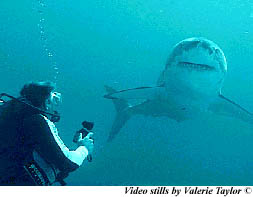
|
In 1997 the International Shark Attack File
received 61 reports of shark attack on humans. After investigation, 56 of
these have been assigned to the confirmed "unprovoked attack" category.
Unprovoked attacks are defined as incidents where no human provocation of
the shark preceded the attack. Of the remaining cases, four lacked
sufficient information to categorize the attack and one was determined to
have involved post-mortem "scavenging" by sharks.
The 56
unprovoked attacks occurring in 1997 was higher than the unusually low
total of 36 recorded in 1996, but was less than all-time highs of 72 and
61 that took place in 1995 and 1994, respectively. The number of shark
attacks transpiring in a given year is directly correlated to the amount
of time humans spend in the sea. As the world population continues to
upsurge and the time spent in aquatic recreation rises, we may expect
gradual annual increases in the number of attacks.
Eleven fatalities were verified from attacks occurring in Japan, New
Guinea, South Africa (two each); and Brazil, Djibouti, Mexico, Réunion and
Vanuatu (one each). The fatality rate of 19.6% was slightly higher than
the 1990-1997 average of 13.8%.
More than half of the unprovoked attacks (34 attacks, including one
fatality) occurred in North American waters. Other regions of activity
were Australia (five non-fatal attacks); Asia (four fatal attacks); Africa
(three fatal and one non-fatal attacks); South America and Pacific Ocean
islands (each with one fatal and three non-fatal attacks); and Indian
Ocean islands (one fatal attack).
The United States had far more attacks (32, all non-fatal) than any
other country. Fewer numbers of attacks occurred in Australia (5), Brazil
(4), The Bahamas (3), South Africa (3), Japan (2), and New Guinea (2).
Single attacks were reported from Djibouti, Fiji, Réunion, Mexico and
Vanuatu.
Florida had 25 non-fatal unprovoked attacks in 1997, up from the
unusually low 1996 total of 13 but more consistent with totals of 29 and
23 recorded in 1995 and 1994, respectively. Florida historically has had
the highest annual number of attacks among U.S. states, a result of having
a large aquatically-active population, an enormous transient population of
tourists, a large coastline, and an environment favorable to sharks. Other
U.S. attacks, all non-fatal, occurred in California (2), Hawaii (2), Texas
(2), New York (1), and South Carolina (1).
Within Florida, Volusia County had the most (14) shark incidents,
which is largely attributable to high aquatic recreational utilization of
its attractive waters by large numbers of residents and tourists,
especially surfers. Other counties having attacks in 1997 were Flagler
(3); Broward, Palm Beach, St. Lucie (2 each); and Martin (1). One Florida
attack lacked sufficient information to allocate it to a specific county.
Surfers continue to constitute the recreational user group most often
subjected to shark attack with 45% of the 1997 attacks targeting surfers,
wind surfers, and rafters. Swimmers and waders represented 27% of the
attacks and divers, including SCUBA users, snorklers and free divers, were
involved in 26% of the attacks. Kayaks and surf skis were uncommonly (2%)
involved in shark attack incidents. |




